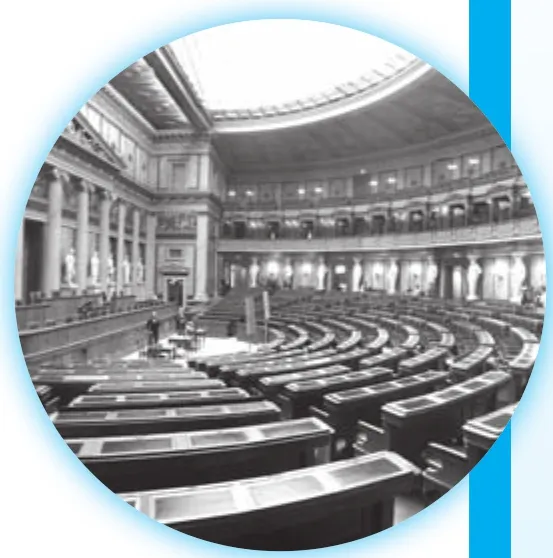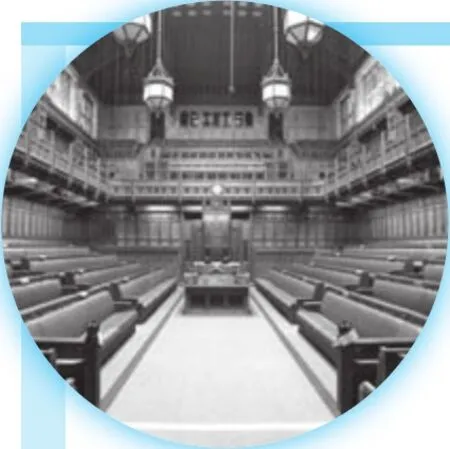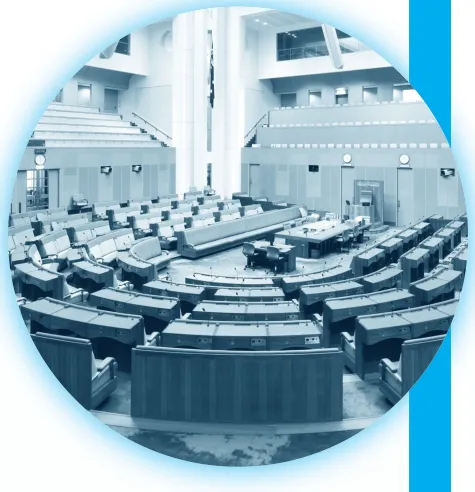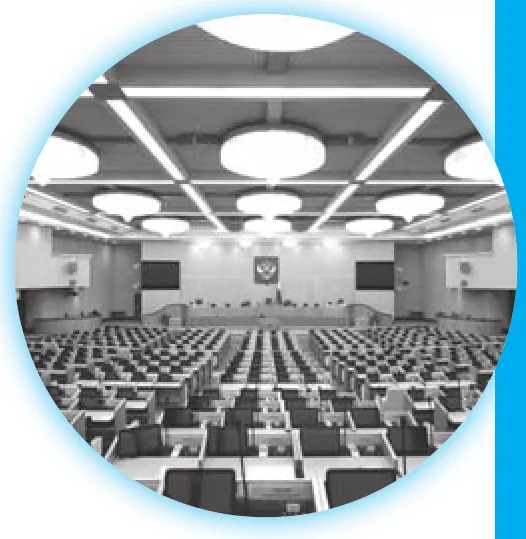Architectural Designs of Legislature in the World
⊙ By Max Cohen de Lara
翻译:丁一
我们都知道,世界各国有不同的地形地貌和风土人情。但据研究,各国立法机构的会议厅远不如各国风景那般多彩,只有区区的五种样式,这多少让人有点意外。到底是怎么回事呢?一起来了解一下吧。
Every one of the United Nations’ 193 member states has a legislatures[立法机关]and each has a plenary[全体会议]hall for its meetings. Although each state has a parliament[议会]of some kind, their plenary chambers[会所]have a very limited number of shapes. Most surprisingly, these buildings have hardly changed since the 19th century.
1) Semicircle[半圆]
The most common shape is the semicircle, which goes back to classical antiquity[古代].
This shape made its neoclassical[新古典主义的]comeback with the French Revolution, which gave birth to its National Assembly and took over the Palais Bourbon for its meetings. Its shape is particularly common in Europe, where, during the 19th century, newly forming nation states adopted the semicircular shape for their legislatures. The semicircle fuses[融合]the members of parliament into a single entity.
Nevertheless, while the Greek semicircle assemblies[集会]had been accessible to all its citizens in a direct democracy, in the new European states, the architecture was used to encourage consensus[一致意见]among a group of representative[代议制的]elites[精英]. Also, the chambers of Senate and House on Capitol Hill convene[集会]in a semicircular setting.

2) Opposing Benches
A second, distinctly different, type is the combative[好斗的]British model of opposing benches, which encourages two parties to see themselves in distinct opposition to one another. It dates back to the pews[教堂长椅]of St. Stephen’s Chapel[小教堂]in the 13th century,where the English king called a form of parliament for the first time.
The setting of two sides that confront[对抗]each other provokes[激起]a more heated debate than the single body that is created in the semicircular setting of most continental parliaments. Because of its historical ties[联系]with Britain, the shape of opposing benches is also found in Commonwealth[英联邦]countries.Architect Le Corbusier used it, for example, in some of the plenary chamber of the regional parliament building in India.

3) Horseshoe[马蹄形]
A third type is a mixture of the previous two, in which the opposing benches bend toward each other on one side of the room to form a horseshoe. This can be seen in many Commonwealth countries, including Australia, Malaysia and South Africa. One of the most beautiful parliament buildings in the world, the Jatiyo Sangshad[孟加拉国立法机构]in Bangladesh designed by architect Louis Kahn, meets in a horseshoe sseettttiinngg..

4) Circle
A fourth, rarer type, is the circle. Only nine parliaments in the world meet in this setting.
Inspired by the Icelandic national parliament of the 8th century,the reintroduction of the circle can be attributed[归因于]primarily to German architect Günther Behnisch, who in the 1980s introduced a radical[完全的]new circular design for the plenary chamber for the West German parliament in Bonn. However, Behnisch’s design wwaass hhaarrddllyy uusseedd aaffter Germany’s reunification[统一], when the parliament moved to Berlin. In the renovated[翻新的]parliament building, architect Norman Foster created a new meeting hall in a semicircular setting.

5) Classroom
The fifth and final type is the classroom, where members of parliament sit in regimented[编排]rows focused on a single speaker in the hall.For instance, the parliaments of Russia and North Korea meet in a classroom setting.
These five architectural designs influence every legislature in the world and tell you how each governs.Architecture sets the stage for our lives; it creates the world we inhabit and shapes how we relate[建立联系]to one another.

CY百科
◆ Commonwealth of Nations 英联邦:由52个独立主权国家组成,成员大多为大英帝国的殖民地或保护国,伊丽莎白女王二世为英联邦的名义元首。英联邦不是一个国家,没有中央政权,不设权力机构。英国和各成员国互派高级专员,代表大使级外交关系。
◆ Palais Bourbon 波旁宫:此为法国国民议会所在地,在塞纳河南岸,是一座有260多年历史的古典建筑,它由意大利设计师Lorenzo Giardini设计,是法国在1722年为路易十四的女儿波旁公爵夫人建造,并由此得名。它被看作是法国法律的象征,1830年起用作国民议会。

参考译文
在联合国的193个成员国中,每个国家都有立法机构,而每个立法机构都有举行全体会议的会堂。虽然各国都有某种形式的议会,但召开全体会议的会堂样式非常有限。最令人惊讶的是,这些建筑物自19世纪以来几乎没有多大改变。
一、半圆形
最常见的是可追溯到古代的半圆形。
随着法国大革命的到来,这种形状实现了自身新古典主义的复兴。诞生于大革命期间的国民议会占领了波旁宫,并在此召开会议。这种形状的会议厅在欧洲特别常见:在19世纪,欧洲新成立国家的立法机构均采用半圆形。半圆形状能让议员们融入到一个整体中。
然而,虽然在古希腊时期,依照直接民主的原则,所有公民都可以进入当时的半圆形议会,但在新成立的欧洲国家里,这种建筑形式则是为了鼓励代议制的精英们达成共识。此外,美国国会山上的参众两院也是在半圆形的会议厅开会的。
二、对坐长凳
第二种类型是好斗的英式对坐长凳——与前一种完全不同,这种布局鼓励双方直接面对彼此。它可以追溯到13世纪时圣斯蒂芬教堂的条凳,英格兰国王在那里第一次召集了可称之为议会的会议。
双方面对面的布局要比大多数欧洲议会的半圆形布局更能挑起激烈的辩论。对坐长凳式的议会厅在与英国有历史渊源的英联邦国家中也可见到。例如,建筑师勒·柯布西耶在为印度一些地方议会大楼设计会议大厅时就采用了这种样式。
三、马蹄形
第三种类型是前两种类型的混合体,即对坐长凳在会堂的一侧合拢,形成马蹄形。这种样式出现在许多英联邦国家,包括澳大利亚、马来西亚和南非等。孟加拉国议会大厦是世界上最美的议会大厦之一,由建筑师路易·卡恩设计,该国立法机构正是马蹄形的布局。
四、圆形
第四种呈圆形,很少见。世界上只有九个国家的议会是在这种布局下开会的。
受到8世纪冰岛议会的影响,德国建筑师京特·贝尼施重新采用圆形样式来设计大会堂。20世纪80年代,他为位于波恩的西德议会会议厅采用了全新的圆形设计。然而,当德国统一,议会搬到柏林后,贝尼施的设计就没怎么被采用了,建筑师曼·福斯特为翻修后的德国国会大厦设计了半圆形的新会议厅。
五、课堂形式
第五种类型是课堂式,即议会成员在整齐划一的一排排座位上坐好,目光集中于会议厅里的唯一发言人。例如,俄罗斯和朝鲜的议会就在课堂式的会议厅里开会。
以上五类建筑设计影响着世界上每一个立法机构,并且体现了不同的治国形式。建筑为我们的生活建造舞台,打造我们生活的世界,并影响我们之间相处的方式。

